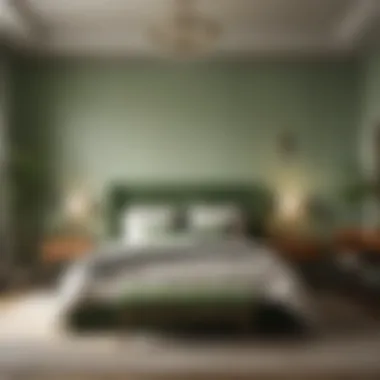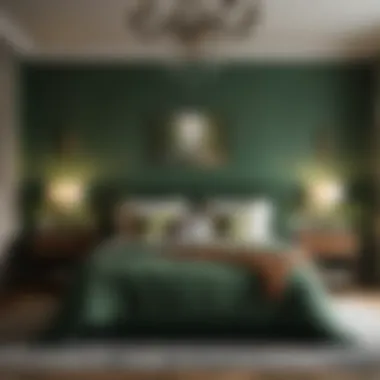Transform Your Bedroom with Serene Green Colors


Intro
In the realm of interior design, color plays a pivotal role in tailoring our personal spaces, influencing both our mood and the overall aesthetic. Green, with its various shades, has gained traction as an excellent choice for bedrooms. It embodies tranquility while also offering a refreshing flair. This article will serve as an extensive guide in pinpointing the best green hues suitable for creating a serene sanctuary within the bedroom.
By examining the psychological impact of green, its harmony with diverse design styles, and offering practical advice for its application, readers will be equipped to transform their bedrooms into calming retreats. Let’s explore the current trends in green bedroom colors.
Current Trends
Color Palettes
Green has quickly evolved from a mere afterthought to a prominent feature in bedroom decor. Today, various palettes are favored for their calming yet sophisticated vibes.
- Soft Sage emerges as a top choice, bringing subtle tones ideal for a serene environment.
- Emerald Green takes a bolder approach, adding richness that can elevate the space while still promoting relaxation.
- Mint Green has also grown in popularity. Its light and airy quality creates a fresh ambiance, making it a favorite for those seeking rejuvenation.
Each of these shades pairs well with neutral elements, such as white or gray, allowing for versatility in design. The current inclination also leans toward a more organic feel, integrating natural materials like wood and stone alongside these green hues.
Popular Styles
When it comes to design styles complementing green, several stand out:
- Scandinavian: Emphasizes simplicity and functionality, often using pastel greens to create an inviting atmosphere.
- Bohemian: Utilizes various greens mixed with vibrant colors and textures, fostering a laid-back vibe.
- Modern Farmhouse: Incorporates deeper greens with rustic elements, blending tradition with contemporary appeal.
- Minimalist: Prefers a monochromatic approach, focusing on a single shade of green to enhance serenity.
These styles highlight green's adaptability, ensuring its status as a staple in bedroom design.
Visual Ideas
Gallery of Styled Bedrooms
Including visual references can help in understanding how green can be effectively implemented in bedroom design. Pictures showcasing various styled bedrooms can serve as inspiration:
- A serene soft sage bedroom with light oak furniture.
- An emerald-themed room featuring gold accents and lush textiles.
- A minimalist space with crisp white bedding and a single mint accent wall.
Before-and-After Transformations
Showcasing before-and-after transformations illustrates the remarkable impact of green. For example, a dark, cluttered bedroom can shift dramatically into a calming oasis simply by repainting with soft sage and introducing lush plants.
"A change in color can completely alter the mood of a space, turning mere walls into a canvas of serenity."
Through understanding trends, styles, and interior applications, housewives and homeowners can confidently select shades of green that resonate with their aesthetic vision while promoting relaxation and comfort in their bedrooms.
The Psychological Impact of Color
Color is not just an aesthetic choice; it significantly influences our emotions, behaviors, and overall well-being. In this article, we will explore the profound effects of color, specifically focusing on green shades in bedroom design. The collaborative relationship between color and psychology can affect mood and perception, making it essential to understand how various colors can contribute to our spaces.
In the context of bedrooms, a place dedicated to rest and relaxation, the choice of colors becomes paramount.
Benefits of Color Psychology
Understanding color psychology can help individuals select hues that foster serenity and balance. Green, often associated with nature, evokes feelings of tranquility, rejuvenation, and peace. These psychological attributes make it an ideal candidate for bedrooms.
Moreover, different shades of green can create varying atmospheres in the bedroom. For instance, light greens can impart freshness and openness, while darker greens may instill a sense of grounding and warmth. Both aspects are crucial when designing personal spaces that aim to promote restful experiences.
"Color is the keyboard, the eyes are the harmonies, the soul is the piano with many strings."
— Wassily Kandinsky
Considerations for Choosing Colors
When selecting bedroom colors, it’s important to consider the psychological impact behind them. Each shade communicates different emotions and can significantly alter the ambiance of a room. Therefore, homeowners should reflect on personal preferences and the desired mood they aim to cultivate in their bedroom.
Having a deeper understanding of color psychology can not only make the selection process easier but also can lead to insightful choices that ultimately enhance mental and emotional well-being.


Shades of Green and Their Meanings
Understanding the various shades of green is crucial in determining the ambiance of a bedroom. Green is often associated with nature and tranquility, but different shades can evoke distinct feelings and aesthetics. Choosing the right hue helps create the desired atmosphere. Colors can influence mood, so it is important to select those that promote serenity and personal comfort.
Soft Sage Green
Soft sage green is a subtle and calming color. It embodies a muted elegance that can enhance a bedroom without overwhelming the senses. This shade has gray undertones, which makes it versatile enough to fit into various design styles. Soft sage is particularly well-suited for creating a serene environment. It can work well in both large and small spaces, as it does not make a room feel confined. The color encourages relaxation, making it ideal for a bedroom retreat.
Deep Forest Green
Deep forest green brings to mind rich, natural landscapes. This shade offers a sense of grounding and stability. It can create a cozy feel in a bedroom. However, it is essential to balance it with lighter colors or adequate lighting. Deep forest green pairs well with natural materials, such as wood and stone. This combination helps emphasize the organic feel of the color. It is a favorable choice for those who appreciate a traditional or rustic aesthetic.
Pale Mint Green
Pale mint green is refreshing and inviting. This shade is light and airy, making it an excellent choice for smaller bedrooms. Its cheerful appearance promotes an uplifting atmosphere while maintaining a calm vibe. Pale mint green pairs nicely with white or cream accents, making any space feel fresh and vibrant. It is particularly appealing for those looking to infuse a little color without being too bold. The color schemes with pale mint can be versatile, suitable for various decor styles from modern to vintage.
Olive Green
Olive green is a complex color with a warm and earthy feel. Its muted quality makes it particularly appealing in a bedroom. Olive green can promote feelings of restfulness and balance, which are essential for a good night's sleep. This shade works well in spaces with wooden furniture or plants, seamlessly blending with natural elements. Adding touches of olive green can enhance a sense of harmony in your bedroom. It is a unique choice for house owners who want something different from the more common hues.
Bold Emerald Green
Bold emerald green stands out, offering a striking pop of color. While it can energize a space, it is essential to use it thoughtfully. Bold emerald can be used as an accent color rather than the primary shade in a bedroom. Pairing it with softer tones can create a captivating balance. This color is great for those who want to express their personality through their decor. It can also add a luxe feel to a bedroom, especially when paired with gold or silver accents.
Selecting the Right Green for Your Bedroom
Choosing the right shade of green for your bedroom is essential. This decision shapes the overall ambiance and mood of the space. Each shade conveys a different feeling and energy level. For instance, soothing shades can promote relaxation, while brighter hues might foster energy. Your choice impacts not just how the room looks, but how you feel in it. Factors to consider include the room size, lighting conditions, and design styles of your existing décor.
Considerations for Space Size and Lighting
The size of your bedroom plays a critical role in the selection of green shades. Lighter greens, such as soft sage or pale mint, can make smaller spaces appear larger and more open. In contrast, darker greens like deep forest can create a cozy, cocooning effect, which may be desirable in larger rooms.
Also, consider the natural light that enters the room. A south-facing room benefits from brighter light, allowing bold emerald greens to shine without overwhelming the space. Conversely, a room with less natural light may require lighter greens to avoid a gloomy atmosphere.
In summary, keep these principles in mind:
- Small rooms: Use light shades to invite openness.
- Large rooms: Darker hues can make spaces feel intimate.
- Well-lit rooms: Bold greens can be striking and visually appealing.
- Low-light areas: Opt for lighter greens to maintain vibrancy.
Flooring and Furnishings Compatibility
When selecting green shades, the existing flooring and furnishings are also important. Consider the color of your floors. A neutral wood floor pairs well with a variety of greens, while a dark carpet might require a more muted green to create balance.
Furnishings also play a crucial role. If your furniture is in neutral tones, you have the freedom to explore various green shades. If your furnishings are colorful, ensure that your chosen green does not clash with them.
Here are some guidelines to ensure compatibility:
- Neutral Floors: Almost any green works well.
- Dark Flooring: Choose lighter green shades for contrast.
- Colorful Furniture: Select muted greens to harmonize with bold colors.
Creating a Cohesive Color Palette
A cohesive color palette is vital for a harmonious bedroom. When determining the right shade of green, think about complementary colors. For green, neutral tones such as whites and grays provide a solid foundation. They enhance the green without competing for attention.
Accent colors, like soft pinks or yellows, can add warmth and contrast to the green, making the space dynamic yet serene. When you choose a shade of green, also think about how it will interact with your selected colors.
Here are a few pointers:


- Combine with Neutrals: Whites and grays make green pop.
- Use Accent Colors: Soft pink or yellow can enhance warmth.
- Keep it Limited: Stick to two or three colors for a cohesive look.
"Color creates a mood, and the right green can bring tranquility, freshness, and energy to your personal haven."
Design Styles That Complement Green
The significance of design styles that complement green is rooted in the fundamental role that aesthetics play in creating a serene and inviting bedroom environment. When combined thoughtfully, the color green can enhance the intended mood of any design style. It not only fosters a sense of tranquility but also invites nature into our personal spaces. By understanding various design styles, homeowners can make informed choices that amplify the calming effects of green and yield a cohesive look in their bedrooms.
Minimalist Aesthetics
Minimalist aesthetics center around simplicity and functionality. In a bedroom setting, this style is particularly resonant when blended with gentle shades of green such as soft sage or pale mint. These tones do not overwhelm the senses, allowing for a tranquil atmosphere. The principles of minimalism advocate for the reduction of clutter, which aligns well with green's association with calmness and balance.
Key aspects to consider when integrating minimalism and green include:
- Furnishings: Choose simple furniture with clean lines.
- Textiles: Favor light linens that enhance the feeling of space.
- Accent Colors: Use whites or light grays to balance the green tones.
Incorporating plants as part of the design further bridges the gap between nature and minimalist interiors, leading to a coherent space that feels both modern and relaxing.
Rustic Charm
Rustic charm often draws inspiration from nature, making it a perfect match for vibrant green tones. Whether it is deep forest green or olive green, these colors reflect the richness of the outdoors. Rustic bedrooms usually feature natural materials like wood, stone, and metal, which can be combined effectively with green.
To enhance rustic charm in a green bedroom, pay attention to:
- Materials: Use reclaimed wood for furniture and decor.
- Textures: Layer different fabrics like burlap and wool alongside cotton to create warmth.
- Decorative Elements: Incorporate vintage items or handmade crafts that resonate with nature.
This union fosters an inviting, cozy feel, evoking a retreat into the heart of the countryside. The dual nature of rustic style and green colors can generate an atmosphere conducive to relaxation and rejuvenation.
Modern Eclectic
Modern eclectic design celebrates diversity, allowing various elements to coexist harmoniously. Here, bold greens such as emerald can provide a striking focal point within an otherwise varied color palette. The key to achieving an effective modern eclectic space is to balance different patterns, textures, and colors while retaining a sense of unity.
Important considerations for a modern eclectic bedroom include:
- Mixing Patterns: Combine geometric patterns with floral designs;
- Furniture Choices: Use contemporary pieces that still reflect personality;
- Accent Areas: Mix and match colors, but keep green as a primary hue to tie the look together.
This style encourages personal expression, allowing homeowners to play with shades of green while still maintaining a well-curated room that feels stylish and vibrant.
"Combining green with other bold strategies within eclectic design can create a bedroom that speaks volumes about the homeowner's taste and character."
In sum, the interplay between green shades and various design styles offers endless possibilities. Homeowners can select and adapt these styles to honor both their design aspirations and the innate serenity that green embodies.
Practical Applications of Green in the Bedroom
To enhance the serene ambiance of a bedroom, the practical applications of green should be thoughtfully considered. Green is more than just a color; it can shape how a space feels and functions. Implementing green in a bedroom can increase relaxation and promote a sense of peace. It's crucial to understand how to use this color effectively to create a tranquil retreat.
Painting Techniques and Tips
When choosing to paint a bedroom green, there are several techniques to ensure the color produces the desired effect. One important aspect is selecting the right shade; for example, a softer sage green may provide a calming touch, whereas a bold emerald green could energize the space. Each color choice will influence the room’s overall atmosphere.
Using paint with a matte finish can create a softer feel, while glossy finishes can highlight textures and architectural details.
Consider using the following tips for painting:
- Test Samples on the Wall: Before fully committing, paint swatches and observe how they appear in different lighting.
- Use Accent Walls: A single green wall can add depth without overwhelming the space.
- Layer with Neutrals: Complementing green with white or beige can enhance its calming properties.


Incorporating Green through Textiles
Textiles are an effective way to introduce green into a bedroom without the commitment of paint. Bed linens, curtains, and rugs in green tones can subtly integrate the color into the existing decor. Layers of texture can be achieved through different materials such as cotton, linen, or velvet.
When selecting textiles, consider the following:
- Mix and Match Shades: Combine various shades of green for visual interest.
- Add Patterns: Stripes or floral patterns can create a dynamic look while still maintaining a serene vibe.
- Consider Comfort: Focus on textures that invite coziness, as this enhances the overall restful environment.
Decorative Accents and Accessories
Incorporating green accents and accessories allows for flexibility in design without making significant changes. Items such as green vases, artwork, or lamps can infuse the room with color.
Some effective ways to add green through accessories include:
- Plants and Greenery: Live plants or high-quality artificial options boost air quality and add vibrancy.
- Wall Art: Select art pieces that feature green hues to tie the room together.
- Furniture Accessories: Consider chairs or cushions in green fabric that can be easily switched out when preferences change.
"The right application of green can transform your bedroom into a peaceful sanctuary, boosting both relaxation and style."
By thoughtfully applying green in the bedroom, through painting, textiles, and decorative accessories, you can create an environment that promotes serenity while reflecting personal style.
Maintaining a Balanced Atmosphere
Creating a serene bedroom involves more than just selecting a green hue. It is essential to maintain a balanced atmosphere. This balance provides a calm, welcoming environment conducive to relaxation. When colors are combined thoughtfully, they can enhance tranquility rather than distract from it.
Incorporating greens must be complemented by the right neutrals and accents. Colors too clash can lead to visual discomfort. It is vital to ensure that the chosen greens harmonize with other elements in the room, allowing for a cohesive design that an individual can enjoy daily.
Balancing with Neutrals
Neutrals provide a foundation in any room's design. They bridge the gap between colors, including various shades of green. Using white, beige, or grey can tone down vibrant greens. For example, pairing a soft sage green with crisp white creates a light, airy feeling in the bedroom. This combination also allows the greenery to shine without overwhelming the senses.
Key benefits of balancing greens with neutrals include:
- Visual Relief: Neutrals create a backdrop that can ease the eye, allowing it to settle into the space comfortably.
- Flexibility: Change can be easier with a neutral base. Switching accessories or adding different accent colors keeps the space fresh without repainting every time.
- Timelessness: Neutral colors are classic. They add longevity to the room's style, regardless of green shades that may go in and out of fashion.
Enhancing with Accent Colors
Accent colors breathe life into a green bedroom. They can provide flair while preserving the calming effect that green offers. Incorporating hues like dusty pink, soft blush, or even muted gold can create a vibrant contrast, allowing greens to take center stage.
When selecting accent colors, consider:
- Purpose: Think about what vibes you want the room to emit. Cool colors like blue or lavender can also add serenity.
- Existing Elements: Look at existing furniture and decor. Ensuring accent shades play nicely with other components is critical for creating a harmonized space.
- Small touches: Accents don’t have to dominate the color scheme. Pillows, artwork, and small decorative items can bring in accent colors subtly without overwhelming the green base.
The right balance between neutrals and accent colors creates a harmonious environment supportive of relaxation while allowing individual expression.
In summary, achieving a balanced atmosphere is key in a green bedroom. Neutrals ground the vibrant greens, and accent colors add personality, resulting in a space that promotes both style and serenity.
Final Thoughts on Green Bedroom Colors
Selecting the right colors for a bedroom is a crucial and personal choice. Green has unique qualities that can suggest tranquility and renewal. This article emphasizes the benefits of incorporating green hues into your bedroom, exploring how they can enhance your well-being.
When you think about green, consider its connection to nature. Many find it to be refreshing and calming. Different shades can evoke different feelings. For instance, soft sage promotes relaxation, while deep forest green can bring a sense of depth and coziness. By understanding these nuances, you can select a color that resonates with you personally.
Emphasizing Individual Preference
Individual preference should always guide your color choice. A color that one person loves might not appeal to another. Therefore, it is essential to listen to your instincts when selecting a shade of green. Consider which hues attract you and the memories they invoke. Are there specific environments in nature that soothe you? Those colors can be simple yet powerful options for your bedroom.
Another aspect to consider is how your space and lifestyle interact with color. For example, if you entertain frequently in your bedroom, vibrant shades might energize the space. Conversely, if you desire a serene retreat, softer, muted greens might be the best fit. Ultimately, allowing your individual style and preferences to guide your choice will result in a space that reflects you.
Encouraging Personal Expression through Color
Color is a form of personal expression. Your bedroom should feel like a sanctuary that reflects your identity. By choosing green, you open up a spectrum of possibilities. You can pair it with textures and patterns that resonate with you. Consider integrating various textiles in complementary shades or playing with different finishes like matte or glossy.
It's also worth experimenting with accent colors. The beauty of green is that it goes well with many other tones. This allows you to create a palette that brings out your personality. For instance, light greens can pair nicely with crisp whites and soft grays, while deeper greens may highlight gold or wooden accents.



